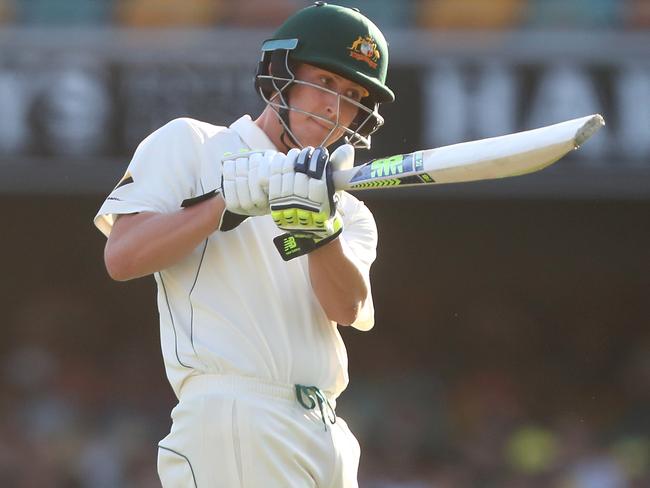Australia’s pace attack replicates South Africa’s probing line and length to great effect
AUSTRALIA’S series loss to South Africa was not in vain. In addition to the enforced changes it brought the pace bowlers also learned a valuable lesson, writes Ian Chappell.

Cricket
Don't miss out on the headlines from Cricket. Followed categories will be added to My News.
AUSTRALIA’S painful series loss to South Africa was not in vain. In addition to the enforced changes it brought - most of which have been highly successful - the pace bowlers also learned a valuable lesson.
South Africa’s relentlessly accurate and probing bowling that precipitated Australia’s horrible batting collapses at Bellerive, was replicated by Josh Hazlewood and company at the Gabba. This time it was the fragile Pakistan batting line-up that displayed an inability to cope.
Ever since returning from an unrewarding stint in Sri Lanka, Hazlewood has homed in on a good line and length for Australian conditions. The resulting consistent performance has stamped him as the foundation stone of the attack.
Helping to ensure that the bowlers’ good work didn’t go unrewarded, the Australian slip cordon performed brilliantly.
This was in stark contrast to their Pakistani counterparts who, in addition to displaying poor catching technique, were found wanting athletically in the vast spaces of the Gabba outfield. When combined with their fragile batting, this is not a recipe for success in Australia or anywhere else.
‘KEEPING BATTLE: Wade’s struggles keep Nevill in India frame
THIRD DAY: Aussies on verge of exacting sweet revenge
MICKEY ARTHUR: Gabba pink-ball Tests unfair
PAKISTAN GREAT: re-call convicted cheat for Boxing Day Test
THEATRICS: Amir’s amateur dramatics on wrong stage

Australia’s dominant form at the Gabba not only put them in a commanding position to win the first Test, it also gave them a psychological advantage for the rest of the series and had them on track to being crowned the kings of pink ball cricket.
Barring a major weather event or the biggest form reversal since the 1981 Headingley Ashes Test, Australia will be three wins from three in pink ball Tests. As a result, look for next season’s day/night Ashes encounter at the Adelaide Oval to become a heated debating point in discussions emanating from England.
Both the Adelaide Oval and the Gabba pitches have been excellent cricket surfaces and the improved pink ball seems to be gaining favour with the players.
The perceived wisdom is that rather than looking to scuff it, as players do with the red cherry to gain swing as it ages, the pink ball needs to be nurtured if you want it to behave helpfully under lights.
However, the ball colour made little difference as the Australians’ relentless accuracy, cleverly interspersed with bursts of aggression, overwhelmed the timid attempts at survival by the Pakistan line-up.
Prior to a series, teams look down the opposing line-up for batsmen who might keep them awake at night. The Australian line-up headed by Ricky Ponting and the Indian order featuring Sachin Tendulkar were full of somnambulism inducing players but a peek at the Pakistani top six should have resulted in a sound night’s sleep.
In contrast, the encouraging early signs from Peter Handscomb and Matt Renshaw suggest Australia now has the makings of a line-up with much more spine to it than just the ever reliable Smith and the explosive David Warner. Both Handscomb and Renshaw have displayed the admirable fight and determination that Smith called for following the Bellerive battering.
The only blips for Australia have been the poor form of Nic Maddinson who appears a little over-anxious and a query-producing missed stumping by Matthew Wade. With an important tour of India looming, Australia must choose it’s best keeper standing up to the stumps and the glaring Gabba miss will have the selectors wondering if Wade deserves that title.

Such was Australia’s dominance in the field that it seemed certain Smith would buck the modern trend of batting the opposition into oblivion and ask Misbah-ul-Haq to follow-on. By Enforcing the follow-on the dominant team can gain a psychological advantage over the opposition that carries over into later matches.
Smith opted to follow the modern trend and as so often happens when the follow-on is not enforced from a position of great strength, a couple of early wickets suddenly puts a check on the batting side and gives an unnecessary boost to the flagging hopes of the bowling side.
Such is Australia’s dominance over Pakistan that even an early second innings slip-up is not going to halt their march to a comprehensive victory. However, they missed an opportunity to really turn the screws at the Gabba, then enjoy a couple of extra days well-earned rest before entering the Boxing Day Test with a head start.


